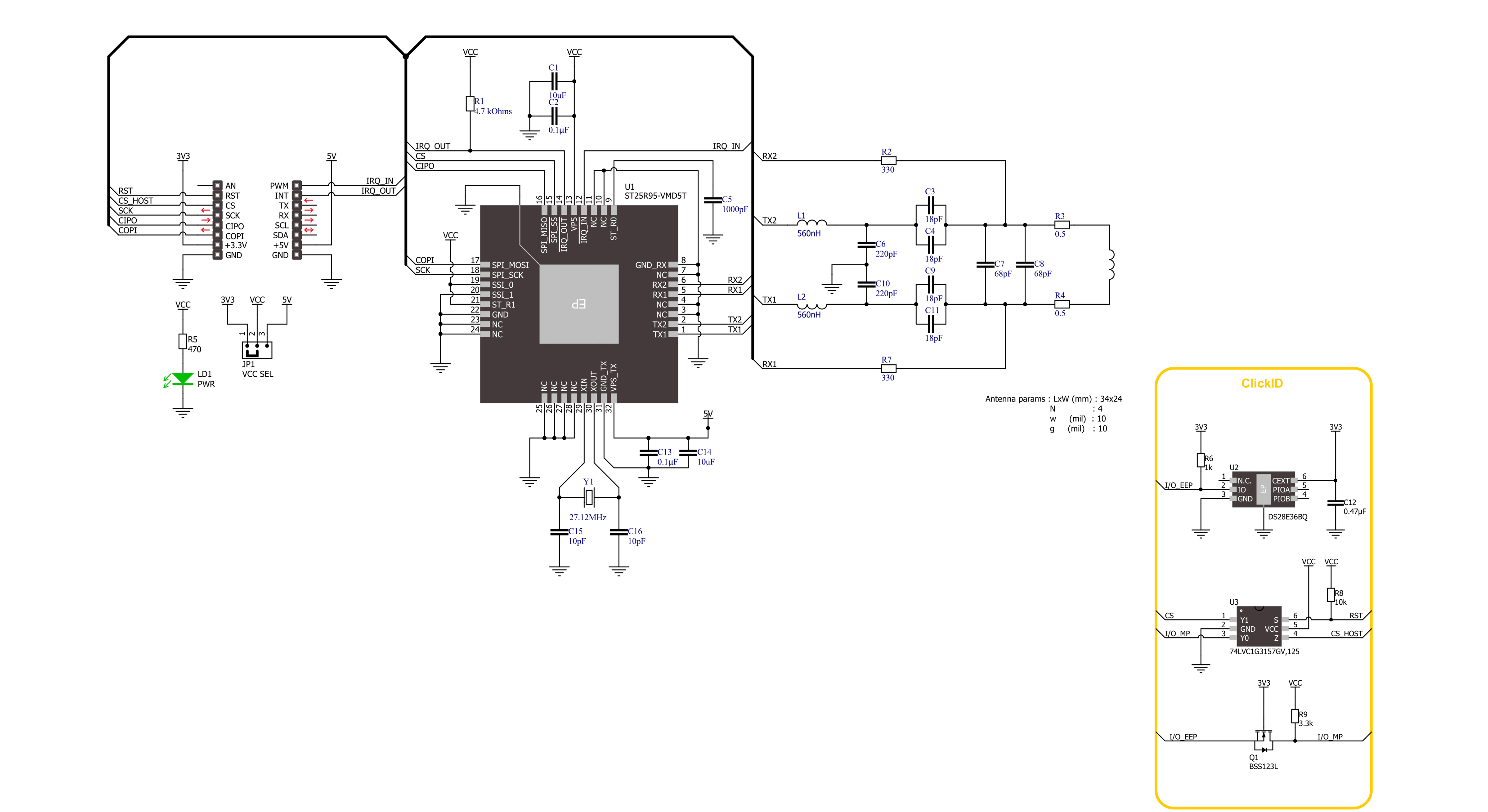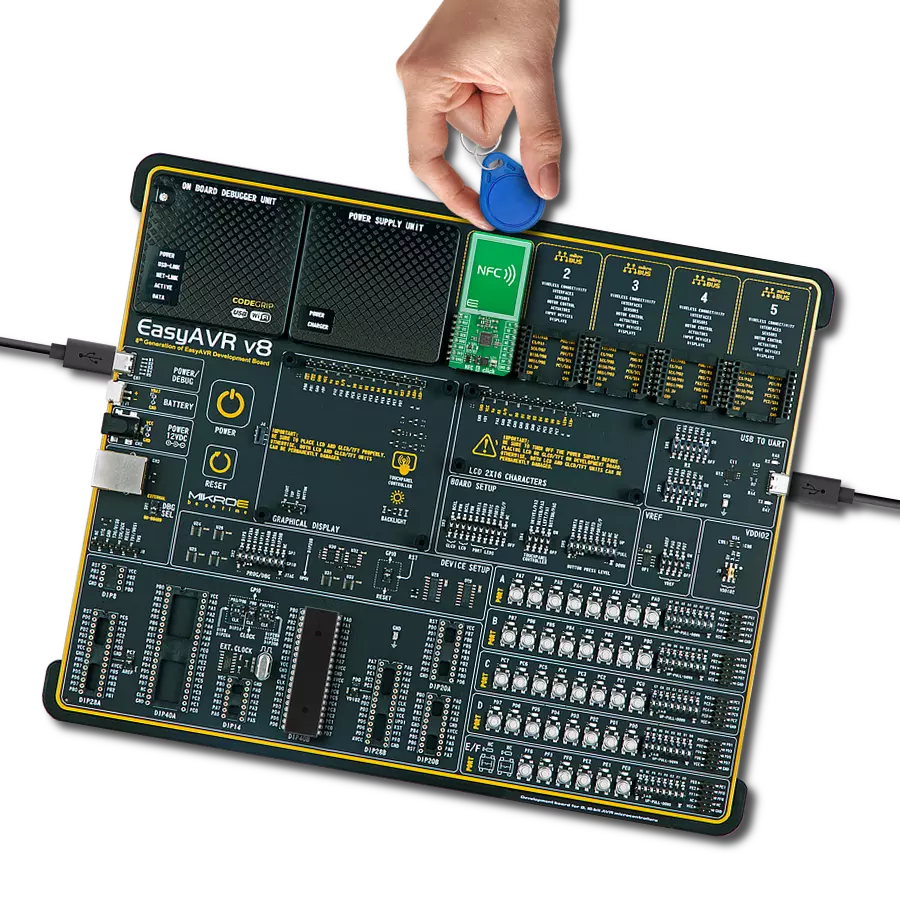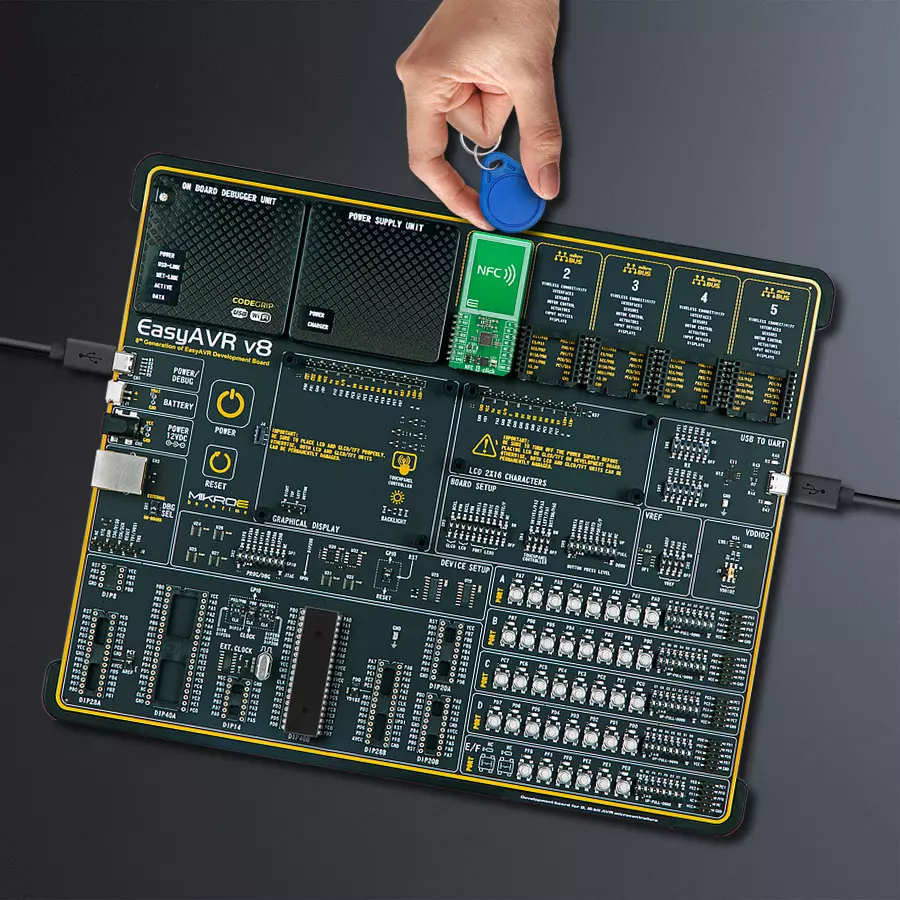Achieve convenient and secure communication between devices using Near Field Communication (NFC) technology
A
A
Hardware Overview
How does it work?
NFC 6 Click is based on the ST25R95, a near-field communication transceiver from STMicroelectronics. It manages frame coding and decoding in Reader and card emulation modes for standard applications such as near-field communication (NFC), proximity, and vicinity standards. The NFC transceiver supports ISO/IEC 14443 Type A communication in reader and card emulation modes and ISO/IEC 14443 Type B, ISO/IEC15693, and FeliCa in reader mode. The ST25R95 embeds an analog front end to provide the 13.56 MHz air interface and supports the detection, reading, and writing of NFC Forum Type
1, 2, 3, 4, and 5 tags. There are two operating modes that ST25R95 supports: wait for event (WFE) and active mode. In active mode, the transceiver communicates actively with a tag or an external host, while the WFE mode includes four low-consumption states: power-up, hibernate, sleep/field detector, and tag detector. NFC 6 Click uses a standard 4-wire SPI serial interface to communicate with the host MCU, supporting clock frequencies of up to 2MHz. There are two interrupt pins: interrupt input (II) and interrupt output (IO). The interrupt input allows you to control WFE events. When it is ready, the NFC transceiver
returns a replay over the interrupt output by setting it to a Low logic level. It will remain Low until the host MCU reads the data. The application can use the Interrupt mode to skip the polling stage. This Click board™ can operate with either 3.3V or 5V logic voltage levels selected via the V SEL jumper. This way, both 3.3V and 5V capable MCUs can use the communication lines properly. Also, this Click board™ comes equipped with a library containing easy-to-use functions and an example code that can be used as a reference for further development.
Features overview
Development board
EasyAVR v8 is a development board designed to rapidly develop embedded applications based on 8-bit AVR microcontrollers (MCUs). Redesigned from the ground up, EasyAVR v8 offers a familiar set of standard features, as well as some new and unique features standard for the 8th generation of development boards: programming and debugging over the WiFi network, connectivity provided by USB-C connectors, support for a wide range of different MCUs, and more. The development board is designed so that the developer has everything that might be needed for the application development, following the Swiss Army knife concept: a highly advanced programmer/debugger module, a reliable power supply module, and a USB-UART connectivity option. EasyAVR v8 board offers several different DIP sockets, covering a wide range of 8-bit AVR MCUs, from the smallest
AVR MCU devices with only eight pins, all the way up to 40-pin "giants". The development board supports the well-established mikroBUS™ connectivity standard, offering five mikroBUS™ sockets, allowing access to a huge base of Click boards™. EasyAVR v8 offers two display options, allowing even the basic 8-bit AVR MCU devices to utilize them and display graphical or textual content. One of them is the 1x20 graphical display connector, compatible with the familiar Graphical Liquid Crystal Display (GLCD) based on the KS108 (or compatible) display driver, and EasyTFT board that contains TFT Color Display MI0283QT-9A, which is driven by ILI9341 display controller, capable of showing advanced graphical content. The other option is the 2x16 character LCD module, a four-bit display module with an embedded character-based display controller. It
requires minimal processing power from the host MCU for its operation. There is a wide range of useful interactive options at the disposal: high-quality buttons with selectable press levels, LEDs, pull-up/pulldown DIP switches, and more. All these features are packed on a single development board, which uses innovative manufacturing technologies, delivering a fluid and immersive working experience. The EasyAVR v8 development board is also integral to the MIKROE rapid development ecosystem. Natively supported by the MIKROE Software toolchain, backed up by hundreds of different Click board™ designs with their number growing daily, it covers many different prototyping and development aspects, thus saving precious development time.
Microcontroller Overview
MCU Card / MCU

Architecture
AVR
MCU Memory (KB)
32
Silicon Vendor
Microchip
Pin count
40
RAM (Bytes)
2048
You complete me!
Accessories
RFID tag operating at 13.56MHz adheres to the ISO14443-A standard, ensuring high-frequency communication. This proximity card technology, often exemplified by MIFARE cards, facilitates secure and contactless interactions in applications like access control, public transport, and payment systems. The ISO14443-A standard defines the communication protocol, incorporating anti-collision mechanisms for simultaneous card handling. These RFID tags possess variable memory capacities, ranging from a few bytes to kilobytes, catering to diverse application needs. Ensuring data security, the standard integrates features such as encryption and authentication. These tags, exemplified by MIFARE technology, are widely used for their efficiency and are vital in enhancing convenience and security in diverse identification and access scenarios.
Used MCU Pins
mikroBUS™ mapper
Take a closer look
Click board™ Schematic

Step by step
Project assembly
Track your results in real time
Application Output
1. Application Output - In Debug mode, the 'Application Output' window enables real-time data monitoring, offering direct insight into execution results. Ensure proper data display by configuring the environment correctly using the provided tutorial.

2. UART Terminal - Use the UART Terminal to monitor data transmission via a USB to UART converter, allowing direct communication between the Click board™ and your development system. Configure the baud rate and other serial settings according to your project's requirements to ensure proper functionality. For step-by-step setup instructions, refer to the provided tutorial.

3. Plot Output - The Plot feature offers a powerful way to visualize real-time sensor data, enabling trend analysis, debugging, and comparison of multiple data points. To set it up correctly, follow the provided tutorial, which includes a step-by-step example of using the Plot feature to display Click board™ readings. To use the Plot feature in your code, use the function: plot(*insert_graph_name*, variable_name);. This is a general format, and it is up to the user to replace 'insert_graph_name' with the actual graph name and 'variable_name' with the parameter to be displayed.

Software Support
Library Description
This library contains API for NFC 6 Click driver.
Key functions:
nfc6_send_command- This function sends a desired command by using SPI serial interfacenfc6_read_data- This function reads a response data bytes by using SPI serial interfacenfc6_read_mifare_tag_uid- This function reads the UID of a MIFARE ISO14443-A type tags with 4-byte or 7-byte UIDs
Open Source
Code example
The complete application code and a ready-to-use project are available through the NECTO Studio Package Manager for direct installation in the NECTO Studio. The application code can also be found on the MIKROE GitHub account.
/*!
* @file main.c
* @brief NFC 6 Click example
*
* # Description
* This example demonstrates the use of NFC 6 Click board by reading
* MIFARE ISO/IEC 14443 type A tag UID.
*
* The demo application is composed of two sections :
*
* ## Application Init
* Initializes the driver and logger, performs the Click default configuration and
* reads the device ID.
*
* ## Application Task
* If there's a tag detected, it reads its UID and displays it on the USB UART every 500ms.
*
* @note
* Only ISO14443-A type tags with 4-byte or 7-byte UIDs are compatible with this example.
* We recommend MIKROE-1475 - an RFiD tag 13.56MHz compliant with ISO14443-A standard.
*
* @author Stefan Filipovic
*
*/
#include "board.h"
#include "log.h"
#include "nfc6.h"
static nfc6_t nfc6;
static log_t logger;
void application_init ( void )
{
log_cfg_t log_cfg; /**< Logger config object. */
nfc6_cfg_t nfc6_cfg; /**< Click config object. */
/**
* Logger initialization.
* Default baud rate: 115200
* Default log level: LOG_LEVEL_DEBUG
* @note If USB_UART_RX and USB_UART_TX
* are defined as HAL_PIN_NC, you will
* need to define them manually for log to work.
* See @b LOG_MAP_USB_UART macro definition for detailed explanation.
*/
LOG_MAP_USB_UART( log_cfg );
log_init( &logger, &log_cfg );
log_info( &logger, " Application Init " );
// Click initialization.
nfc6_cfg_setup( &nfc6_cfg );
NFC6_MAP_MIKROBUS( nfc6_cfg, MIKROBUS_1 );
if ( SPI_MASTER_ERROR == nfc6_init( &nfc6, &nfc6_cfg ) )
{
log_error( &logger, " Communication init." );
for ( ; ; );
}
if ( NFC6_ERROR == nfc6_default_cfg ( &nfc6 ) )
{
log_error( &logger, " Default configuration." );
for ( ; ; );
}
uint8_t device_id[ 13 ] = { 0 };
nfc6_send_command ( &nfc6, NFC6_CMD_IDN, NULL, NULL );
if ( NFC6_OK == nfc6_read_data ( &nfc6, device_id, sizeof ( device_id ), NULL ) )
{
log_printf ( &logger, " Device ID: %s\r\n", device_id );
}
log_info( &logger, " Application Task " );
}
void application_task ( void )
{
uint8_t tag_uid[ NFC6_TAG_UID_MAX_LEN ] = { 0 };
uint8_t tag_uid_len = 0;
if ( NFC6_OK == nfc6_read_mifare_tag_uid ( &nfc6, tag_uid, &tag_uid_len ) )
{
log_printf( &logger, " TAG UID: " );
for ( uint8_t cnt = 0; cnt < tag_uid_len; cnt++ )
{
log_printf( &logger, "0x%.2X ", ( uint16_t ) tag_uid[ cnt ] );
}
log_printf( &logger, "\r\n----------------------------------\r\n" );
Delay_ms ( 500 );
}
}
int main ( void )
{
/* Do not remove this line or clock might not be set correctly. */
#ifdef PREINIT_SUPPORTED
preinit();
#endif
application_init( );
for ( ; ; )
{
application_task( );
}
return 0;
}
// ------------------------------------------------------------------------ END


































